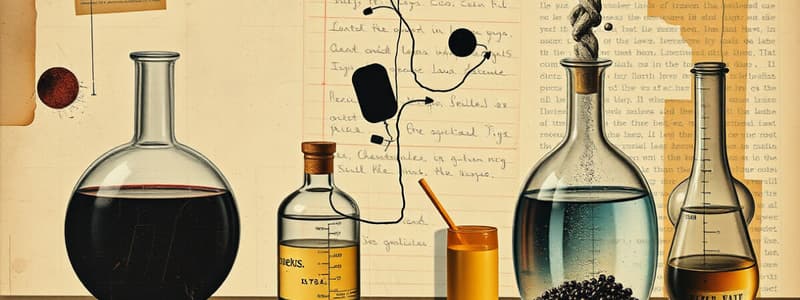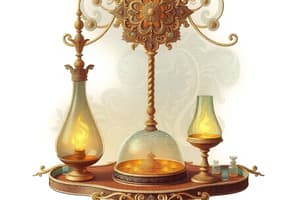Podcast
Questions and Answers
A gas sample contained in a cylinder equipped with a movable piston occupied 300.0 mL at a pressure of 2.00 atm. What would be the final pressure if the volume were increased to 500.0 mL at constant temperature?
A gas sample contained in a cylinder equipped with a movable piston occupied 300.0 mL at a pressure of 2.00 atm. What would be the final pressure if the volume were increased to 500.0 mL at constant temperature?
1.2 atm
A 50.00 L sample of gas collected in the upper atmosphere at a pressure of 18.30 torr is compressed into a 0.1500 L container at the same temperature. What is the final pressure?
A 50.00 L sample of gas collected in the upper atmosphere at a pressure of 18.30 torr is compressed into a 0.1500 L container at the same temperature. What is the final pressure?
6,100 torr
A balloon contains 1.50 L of air at 1.00 atm. It is taken underwater to a depth at which the pressure is 3.00 atm. What is the new volume of the balloon assuming the temperature remains constant?
A balloon contains 1.50 L of air at 1.00 atm. It is taken underwater to a depth at which the pressure is 3.00 atm. What is the new volume of the balloon assuming the temperature remains constant?
0.5 L
A sample of krypton gas occupies 75.0 mL at 0.400 atm. If the temperature remains constant, what volume would the krypton occupy at 4.00 atm?
A sample of krypton gas occupies 75.0 mL at 0.400 atm. If the temperature remains constant, what volume would the krypton occupy at 4.00 atm?
Several balloons are inflated with helium to a volume of 0.75 L at 27°C. If the temperature drops to 22°C, what would be the volume of the balloon when found, assuming no helium has escaped?
Several balloons are inflated with helium to a volume of 0.75 L at 27°C. If the temperature drops to 22°C, what would be the volume of the balloon when found, assuming no helium has escaped?
A weather balloon is filled to a volume of 150.0 L when the temperature is 10.0°C. What would be the volume of the balloon after it rises to an altitude where the temperature is -8.00°C?
A weather balloon is filled to a volume of 150.0 L when the temperature is 10.0°C. What would be the volume of the balloon after it rises to an altitude where the temperature is -8.00°C?
A fixed quantity of gas at 23.0°C has a volume of 10.3 L. What will the volume be if the temperature is increased to 145°C while the pressure remains constant?
A fixed quantity of gas at 23.0°C has a volume of 10.3 L. What will the volume be if the temperature is increased to 145°C while the pressure remains constant?
A sample of gas occupies a volume of 7.50 L at 28.0°C. At what temperature does the volume become 4.00 L if the pressure is kept constant?
A sample of gas occupies a volume of 7.50 L at 28.0°C. At what temperature does the volume become 4.00 L if the pressure is kept constant?
A gas occupies a volume of 100.0 mL at 27.0°C. At what temperature would the volume be 50.0 mL?
A gas occupies a volume of 100.0 mL at 27.0°C. At what temperature would the volume be 50.0 mL?
A sample of gas has a pressure of 100.0 torr at 27.0°C. Calculate the pressure if the temperature is changed to 127°C while the volume remains constant.
A sample of gas has a pressure of 100.0 torr at 27.0°C. Calculate the pressure if the temperature is changed to 127°C while the volume remains constant.
A gas initially at STP is changed to 248 K. What is the final pressure of the gas?
A gas initially at STP is changed to 248 K. What is the final pressure of the gas?
A gas occupies a volume of 50.0 mL at 27°C and 630 mmHg. At what temperature, in °C, would the pressure be 101.3 kPa if the volume remains constant?
A gas occupies a volume of 50.0 mL at 27°C and 630 mmHg. At what temperature, in °C, would the pressure be 101.3 kPa if the volume remains constant?
A sample of gas has a pressure of 700 mmHg at 30.0°C. At what temperature would the pressure be 600 mmHg if the volume remains constant?
A sample of gas has a pressure of 700 mmHg at 30.0°C. At what temperature would the pressure be 600 mmHg if the volume remains constant?
A sample of gas is initially at STP. What would the pressure be if the temperature were increased to 819°C?
A sample of gas is initially at STP. What would the pressure be if the temperature were increased to 819°C?
What is the definition of Moles and Volume Law?
What is the definition of Moles and Volume Law?
What is the definition of Combined Gas Law?
What is the definition of Combined Gas Law?
Flashcards
Boyle's Law
Boyle's Law
The volume of a gas is inversely proportional to its pressure when the temperature remains constant.
Charles's Law
Charles's Law
The volume of a gas is directly proportional to its absolute temperature (measured in Kelvin) when the pressure remains constant.
Gay-Lussac's Law
Gay-Lussac's Law
The pressure of a gas is directly proportional to its absolute temperature (measured in Kelvin) when the volume remains constant.
Combined Gas Law
Combined Gas Law
Signup and view all the flashcards
Dalton's Law of Partial Pressures
Dalton's Law of Partial Pressures
Signup and view all the flashcards
Molar Volume of a Gas
Molar Volume of a Gas
Signup and view all the flashcards
Study Notes
Boyle's Law
- Boyle's Law relates pressure and volume at constant temperature; pressure increases as volume decreases.
- Initial conditions: 300.0 mL at 2.00 atm leads to a final pressure of 1.2 atm when volume increases to 500.0 mL.
- Compressing a 50.00 L gas sample from 18.30 torr to 0.1500 L results in a final pressure of 6,100 torr.
- A balloon's volume of 1.50 L at 1.00 atm decreases to 0.5 L when submerged to 3.00 atm.
- For krypton gas, a volume of 75.0 mL at 0.400 atm reduces to 7.5 mL at 4.00 atm.
Charles' Law
- Charles' Law connects temperature and volume at constant pressure; volume increases with temperature.
- A helium balloon inflated to 0.75 L at 27°C decreases to approximately 0.7375 L at 22°C.
- A weather balloon rises from 150.0 L at 10.0°C to about 140.5 L at -8.00°C.
- A gas at 10.3 L and 23.0°C expands to 14.5 L when heated to 145°C.
- Volume of 7.50 L at 28.0°C contracts to 4.00 L at -112.47°C with constant pressure.
- A gas at 100.0 mL and 27.0°C decreases to 50.0 mL at -123°C.
Gay-Lussac's Law
- Gay-Lussac's Law relates pressure and temperature at constant volume; pressure increases with temperature.
- A gas with a starting pressure of 100.0 torr and 27.0°C has a final pressure of approximately 133.3 torr at 127°C.
- A gas at STP converted to 248 K shows a final pressure of 0.908 atm.
- A gas at 50.0 mL and 27°C, under 630 mmHg, drops to -224.76°C to reach 101.3 kPa.
- A gas with an initial pressure of 700 mmHg at 30.0°C drops to -13.3°C to have a final pressure of 600 mmHg.
- For a gas at STP with a temperature increase to 819°C, the pressure rises to 4 atm.
Combined Gas Law
- The Combined Gas Law encompasses Boyle's, Charles', and Gay-Lussac's laws, relating pressure, volume, and temperature together.
- Used to solve problems where more than one variable changes.
- Essential for determining how multiple conditions affect gas behavior in various scenarios.
Studying That Suits You
Use AI to generate personalized quizzes and flashcards to suit your learning preferences.




